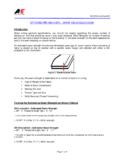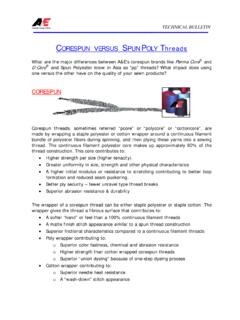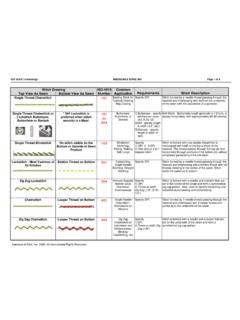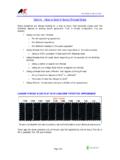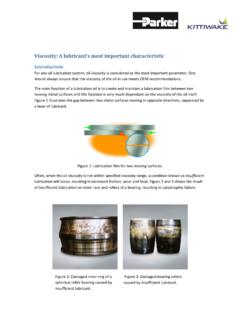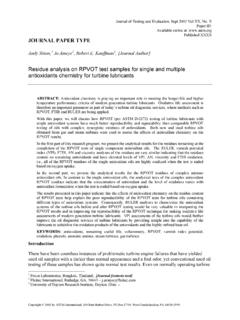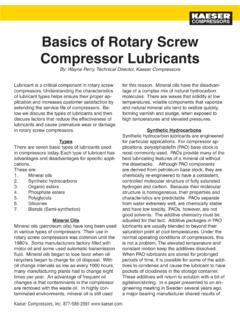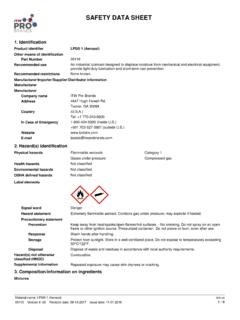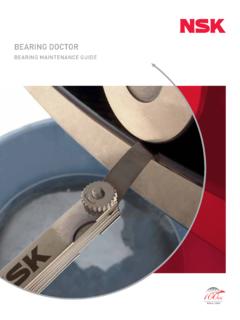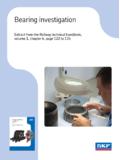Transcription of MINIMIZING THREAD BREAKAGE & SKIPPED …
1 TECHNICAL BULLETIN Page 1 MINIMIZING THREAD BREAKAGE & SKIPPED stitches THREAD BREAKAGE and SKIPPED stitches are common aggravations on any sewing floor because they interrupt production, affect quality, and reduces the earnings and efficiency of production operators. THREAD BREAKAGE and SKIPPED stitches can be caused by many factors including: wrong THREAD for the application quality defects in the THREAD improper needle / THREAD size relationship worn or defective THREAD guides or eyelets improper threading excessive machine THREAD tension defective needle or improper positioning of the needle needle heat worn or defective sewing machine parts (burrs or sharp surfaces on THREAD handling or stitch forming devices) sewing machines out of adjustment improper feeding improper operator handling flagging As you can see then there are many variables that impact THREAD BREAKAGE and SKIPPED stitches .
2 Initially we will focus on the characteristics in THREAD that impact THREAD BREAKAGE , but later we will also discuss a logical approach used for trouble-shooting THREAD BREAKAGE . CHARACTERISTICS IN THREAD THAT AFFECT THREAD BREAKAGE & SKIPPED stitches The Key Product Characteristics in THREAD that have the greatest impact on THREAD BREAKAGE and SKIPPED stitches include: Proper Loop Formation Absence of Yarn Imperfections Proper Lubrication Good Ply Security or Ply Adhesion TECHNICAL BULLETIN Page 2 Let s take a closer look at each of these and the physical properties in THREAD that impact performance. PROPER LOOP FORMATION Every sewing machine uses a needle to pass THREAD through the seam to form a stitch. Most sewing machines begin their stitch forming cycle when the needle starts to rise from the bottom of its stroke.
3 (1) The upward motion of the needle, (2) the clamping action of the THREAD between the needle blade and the fabric, and (3) the holding of the seam in a stationary position all play an important role in proper loop formation. Loop Formation refers to the forming of a loop for the stitch-forming device ( , hook, looper, spreader) to enter. When the needle THREAD loop is formed, three things can happen and two of them are bad. Ideally the stitch forming device will enter the loop and continue to form the stitch, however, if an improper THREAD loop is formed, the stitch forming device can strike the THREAD causing the THREAD to break or miss the loop causing a SKIPPED stitch. The THREAD characteristics that impact loop formation include: Elongation or stretchiness of the THREAD Initial modulus or initial resistance to stretching Twist direction & twist level Liveliness of the THREAD Frictional characteristics needed to set a balanced stitch If the needle size - THREAD size relationship is improper, the THREAD will not be properly clamped on the scarf side of the needle and poor loop formation will occur.
4 If the seam is not held in a stationary position when the needle is rising, the seam will rise with the needle and not form a proper needle loop. This condition, called flagging, is one of the most common causes of SKIPPED stitches and THREAD BREAKAGE . TECHNICAL BULLETIN Page 3 Many times a SKIPPED stitch or THREAD break will occur when crossing another seam. This problem could occur due to the additional thickness that the needle has to penetrate. This may cause additional tension to the THREAD or cause the needle to deflect away from the stitch-forming device. However, many times the skip or break occurs right before or after the thickness and usually this the result of flagging. This happens when a portion of the presser foot is still on the seam and the foot is no longer clamping the fabric securely.
5 Therefore, as the needle begins to rise, the fabric moves up with the needle and a poor needle loop formation occurs. THREAD Elongation & Initial modulus The inherent stretchiness or elongation of the THREAD is generally determined by the fiber type and THREAD construction being used. For example, both nylon and polyester threads have a much higher elongation than 100% cotton threads. On the following graph you can see the relationship between tension and elongation. The cotton THREAD stretches approximately 3 to 4% before it breaks. Polyester THREAD , on the other hand, stretches approximately 17 to 20% before it breaks. The polyester THREAD has a higher elongation at break that contributes to greater seam elasticity and seam strength. A key product characteristic developed in our synthetic threads to enhance loop formation is a high initial modulus or initial resistance to stretching.
6 A THREAD with a higher initial modulus will minimize the amount that the THREAD stretches as the needle approaches the bottom of its travel. Therefore, when the needle begins to rise, the THREAD will be relaxed so a proper needle loop will be formed. When the THREAD is stretched as the needle reaches the bottom of its travel in the stitch formation cycle, the THREAD will recover to its original un-stretched length as the needle begins to rise. The more the THREAD is stretched, the later a needle loop will be formed and the smaller the target the stitch forming device has to enter to form a proper stitch. The end result may be a SKIPPED stitch or THREAD BREAKAGE . The physical properties in THREAD that impact how much the THREAD is stretched during the sewing process include: TECHNICAL BULLETIN Page 4 Elongation properties of the fiber being used Initial modulus - the THREAD s initial resistance to stretching Frictional characteristics of the THREAD needed to set a balanced stitch Note: Regardless of the type of THREAD being used, as more and more tension is applied to the THREAD , the THREAD will stretch more affecting loop formation.
7 Improper loop formation will result in a higher frequency of sewing interruptions. This is why it is recommended to always adjust the sewing machines THREAD handling system to sew with minimum THREAD tension. Below is a recommended procedure for balancing the stitch on a any sewing machine: 1) Set the bottom tension (bobbin or looper) to a minimum but still forms a consistent stitch. 2) Reduce the needle THREAD tension until the stitch appears to be loose on the bottom side of the seam, then tighten the top tension until a balanced stitch is achieved. THREAD Lubricant The THREAD lubricant is another important variable in proper loop formation equation. Ideally the THREAD lubricant will give the THREAD a consistent dynamic tension as it passes through the sewing machine s THREAD guides and tension devices and also allow the THREAD to form a balanced stitch with minimum force.
8 This will minimize the amount that the THREAD stretches allowing a proper needle loop to form. Later in this bulletin we will look at some of the variables that impact the frictional characteristics of sewing THREAD . UNIFORMITY - CONSISTENCY OF PHYSICAL PROPERTIES Many factors affect the uniformity of the THREAD . By uniformity, we are referring to the consistency in physical properties regarding: Yarn Construction Yarn Diameter (absence of yarn imperfections like knots and slubs, etc.) Strength Elongation and modulus Lubrication Cone build or wind TECHNICAL BULLETIN Page 5 These are the primary THREAD properties that have an impact on sewability. Other factors that affect seam integrity and seam appearance include: Color Color Fastness Resistance to seam degradation (chemicals, abrasion, UV, etc.)
9 Loop strength For the sake of this technical bulletin, we will focus on the factors that affect THREAD BREAKAGE . Yarn Construction Continuous filament THREAD constructions are more consistent in physical properties and diameter and generally have a higher tenacity or strength per size than spun constructions made with staple fibers. Below is a ranking of THREAD constructions regarding consistency of construction: Monofilament Monocord Twisted Multifilament Textured Air Entangled Corespun Spun The reason why spun constructions are not as consistent as continuous filament THREAD constructions is that spun threads are made from staple fibers that are spun into a yarn. Thousands of staple fibers have to be aligned and twisted together to make the THREAD . Spun threads are also generally weaker than continuous filament threads of equal size and therefore may break during the spinning and twisting processes requiring knots or air splices.
10 However, spun threads have the following advantages: Fibrous or fuzzy surface has a softer hand Fibrous or fuzzy surface refracts light so it blends in better with spun fabrics The fibrous surface contributes to superior frictional characteristics Generally, spun threads are less expensive than continuous THREAD constructions like Corespun and Twisted multifilament THREAD constructions. TECHNICAL BULLETIN Page 6 Uniformity - Absence of Yarn Imperfections Yarn imperfections like knots and slubs will generally cause THREAD BREAKAGE ; that is why A&E has reengineered many of its processes to eliminate major imperfections. This includes the use of Air Splices where knots used to be used. We believe that no knot is a good knot . Pay Off The Cone Due To The Build Or Wind To minimize THREAD BREAKAGE , it is imperative that the THREAD feed off the cone with the least amount of resistance.


